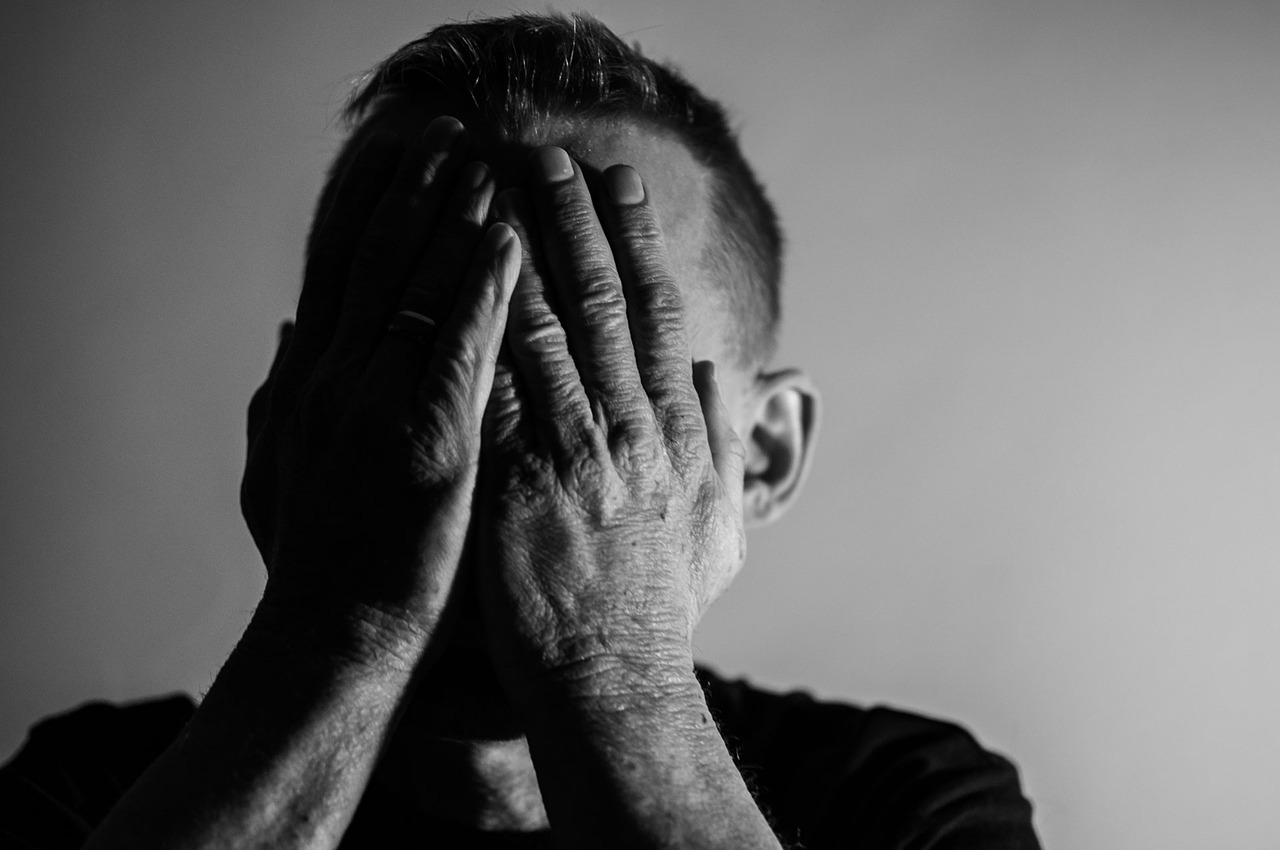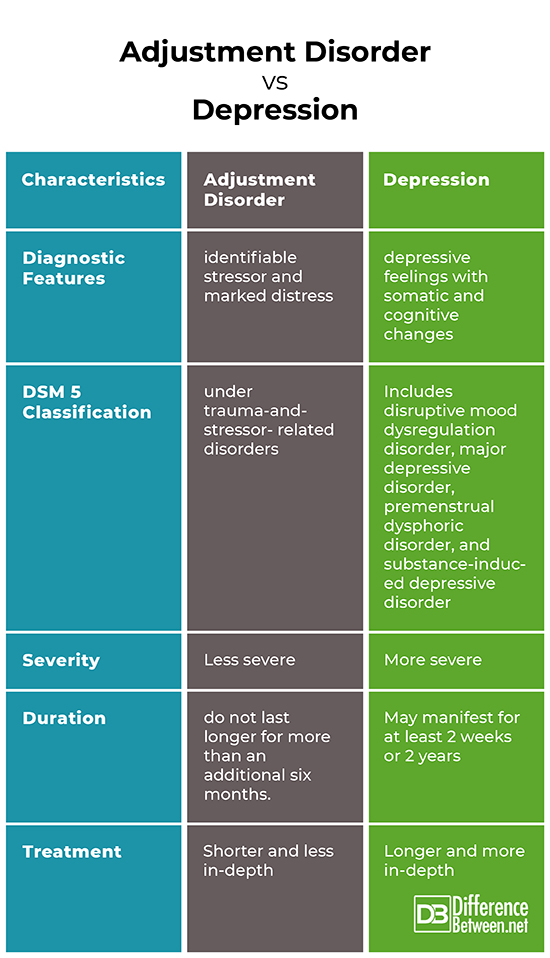Difference Between Adjustment Disorder and Depression
The line between adjustment Disorder (AD) and depression may be confusing for some since AD is sometimes called situational depression, reactive depression, or exogenous depression. Both of these mental disorders may be triggered by stressors and cause certain degrees of impairment regarding performing daily tasks. Moreover, AD may also be specified by clinicians as “with depressed mood”. However, AD is under trauma and stressor related disorders while depressive disorders include disruptive mood dysregulation disorder, major depressive disorder, premenstrual dysphoric disorder, and substance-induced depressive disorder. The following paragraphs further expound on their differences.
What is Adjustment Disorder?
AD is due to the inability of the individual to cope with a new life situation such as unemployment, marriage, change of community, and others. This is sometimes referred to as “situational” depression since it is caused by a stressful condition. It is also known as “reactive” depression since the condition is attributed to the response of the patient to the event. AD may also be termed as “exogenous” depression since the symptoms are triggered by an external factor such as divorce, unemployment, and family conflict. As compared to the other diagnoses, this is most probably the least stigmatizing of them all. The Diagnostic and Statistical Manual of Mental Disorders, 5th Edition (DSM 5) specifies the following criteria for AD:
- The emotional or behavioral symptoms manifested within three months of the onset of the stressor.
- The experienced distress is out of proportion to the severity of the source of stress.
- There is a significant impairment in various areas of functioning such as work and family.
- The symptoms do not last longer for more than an additional six months.
- AD may be specified as: with depressed mood, with anxiety, with mixed anxiety and depressed mood, with disturbance of conduct, with mixed disturbance of emotions and conduct, or unspecified.
What is Depression?
Depressive disorders are generally characterized by sadness, a sense of emptiness, irritable mood, and negative somatic and cognitive changes. The following are the different kinds of depressive disorders and their general descriptions:
- Disruptive Mood Dysregulation Disorder
This is mainly characterized by persistent irritability and temper outbursts which last for at least 12 months.
- Major Depressive Disorder
The symptoms include depressed mood, feelings of worthlessness, and diminished interest for most of the day. Somatic changes include significant weight loss or gain, insomnia or hypersomnia, psychomotor agitation or retardation, and fatigue. Cognitive changes include diminished ability to think and recurrent thoughts of death. These symptoms last for at least 2 weeks.
- Persistent Depressive Disorder
The description is the same with major depressive disorder but the duration of the symptoms is at least 2 years.
- Premenstrual Dysphoric Disorder
Women experience marked affective lability, depressed mood, irritability, anger, anxiety, loss of interest, difficulty to concentrate, lethargy, change in appetite, change in sleeping pattern, muscle pain, and/or a sensation of bloating during the final week before the onset of menses.
- Substance-induced Depressive Disorder
The depression is caused by the ingestion of medication or psychoactive drugs.
Difference between Adjustment Disorder and Depression
Diagnostic Features
Adjustment Disorder’s diagnostic feature is an identifiable stressor and marked distress. A diagnosis of “Adjustment Disorder with depressed mood” (also known as situational depression) is characterized by low mood, tearfulness, or hopelessness due to the traumatic event. On the other hand, depression is mainly described as being sad, empty, and/or irritable; these feelings are accompanied by significant negative cognitive and somatic changes such as inability to concentrate and sleep.
DSM 5 Classification
Adjustment disorder is under Trauma-and-Stressor-Related Disorders while Depressive Disorders include disruptive mood dysregulation disorder, major depressive disorder, premenstrual dysphoric disorder, and substance-induced depressive disorder.
Severity
Adjustment disorder often resolves after some months and talk therapy often results to improvement. As compared to the other diagnoses, this is most probably the least stigmatizing of them all. On the contrary, depression may last longer, may have higher suicide risk, and has more complications.
Duration
In adjustment disorder, the emotional or behavioral symptoms manifested within three months of the onset of the stressor. Also, such symptoms do not last longer for more than an additional six months. As for depression, the symptoms may manifest for at least two weeks (Major Depressive Disorder) or for two years (Persistent Depressive Disorder).
Treatment
Mild cases of adjustment disorder often get better without clinical intervention as some achieve recovery after several lifestyle changes and joining support groups. Others with severe conditions consult psychotherapists and may receive prescriptions for anxiety and depression. Clinical depression often requires longer and more in-depth management. Some patients need to be hospitalized due to self-harm behaviors. Aside from lifestyle changes, patients may be prescribed with antidepressants along with regular therapy.
Adjustment Disorder vs Depression
Summary
- Both adjustment disorder and depression may be triggered by stressors and cause certain degrees of impairment regarding performing daily tasks.
- Adjustment Disorder is sometimes called situational depression, reactive depression, or exogenous depression.
- Adjustment disorder is due to the inability of the individual to cope with a new life situation such as unemployment, marriage, change of community, and others.
- Unlike adjustment disorder, depression may occur without an identifiable stressor.
- Depressive disorder is generally characterized by sadness, a sense of emptiness, irritable mood, and negative somatic and cognitive changes.
- Adjustment disorder is under trauma-and-stressor-related disorders in DSM 5 while depressive disorders include mood dysregulation disorder, major depressive disorder, premenstrual dysphoric disorder, and substance-induced depressive disorder.
- Adjustment disorder is less severe as compared to depressive disorders.
- Depression may often last longer than adjustment disorder.
- The treatment for adjustment disorder is generally shorter and less in-depth as compared to that of depression.
- Difference Between Hematoma and Melanoma - February 9, 2023
- Difference Between Bruising and Necrosis - February 8, 2023
- Difference Between Brain Hematoma and Brain Hemorrhage - February 8, 2023
Search DifferenceBetween.net :
Leave a Response
References :
[0]Image credit: https://www.flickr.com/photos/nickharris1/5089846127
[1]Image credit: https://pixabay.com/de/photos/depression-traurigkeit-mann-2912424/
[2]American Psychiatric Association. Diagnostic and Statistical Manual of Mental Disorders, 5th Ed. Washington, DC: American Psychiatric Publishing, 2013. Print.
[3]Butcher, James, Hooley, Jill, and Mineka Susan. Abnormal Psychology. New York, NY: Pearson, 2014. Print.
[4]Oltmanns, Thomas, and Emery Robert. Abnormal Psychology. New York, NY: Pearson. 2015. Print.



